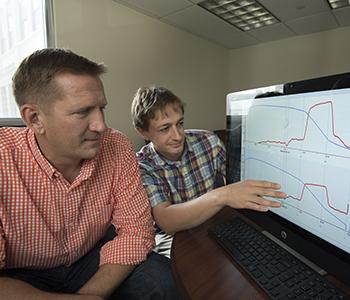We saw this July how researchers can help beneficial drugs evade an overly belligerent immune system by coating them in a honey mixture. Perhaps unsurprisingly, highly evolved pathogens are able to sneak past and even distract the defense mechanisms of plants. Bringing hope to the situation is a research group at Michigan State University at East Lansing who has found out a way to empower plants against such tricky attacks.
Read MoreRecent Posts
Tags: Michigan State University, 2015, BioResearch Product Faire Event, MI, East Lansing, MSU
We can learn a lot from nature in the realm of imaging. We’ve seen researchers at Washington University in St. Louis take cues from the mantis shrimp, a creature with depth perception in each eye and four times the color receptors of humans. Now, at the University of Wisconsin, Madison, bioengineers are setting records with a new phototransistor that takes simple ideas from the eyes of mammals.
Read MoreTags: WI, University of Wisconsin Madison, UWisc, 2015, BioResearch Product Faire Event, Madison
Though it’s common knowledge that fruits and vegetables are part of a balanced diet, life science researchers continue to find health benefits in these foods beyond what anyone expected. Take the case of Ohio State University, for example, who three years ago found out that apples can lower levels of bad cholesterol. A new study from the University of Michigan, Ann Arbor suggests that bananas can fight off viruses we’d otherwise be susceptible to.
Read MoreTags: University of Michigan Ann Arbor, 2015, Ann Arbor, BioResearch Product Faire Event, MI, UMich
Our immune system is our best defense against sickness on a day-to-day basis, and bioresearchers have been trying to ramp it up to handle bigger threats for some time now. A research lab from MSU found that fish oil can significantly boost immune activity, and a UCSF team discovered genetic “enhancers” that help prevent autoimmune diseases. At the Washington University in St. Louis, scientists are finding that our immune system has the potential to be much stronger and are discovering how to tap into that potential.
Read MoreTags: Washington University St. Louis, WashU, 2015, BioResearch Product Faire Event, MO, St Louis
Though they are easy to take for granted, our five senses are the best tools we have for interacting with our environment. This is why a large sector of biotechnology is dedicated to preserving and improving these senses. We've seen Ann Arbor researchers restore lost sense of smell and Chicago researchers restore lost vision in years past. At the University of Cincinnati, a research group is working on effectively restoring hearing in children.
Read MoreTags: University of Cincinnati, 2015, BioResearch Product Faire Event, Cincinnati, OH, UCinci
As the field of regenerative medicine rapidly progresses, personalized medicine is becoming more and more common in the life science headlines. In the Science Market Update alone, we’ve witnessed researchers grow replicas of human hearts at the Mayo Clinic in Rochester, stomachs and intestines at the University of Cincinnati, and even brains at The Ohio State University. Now a research team at the University of Illinois, Urbana-Champaign is following suit by growing a tumor outside of the body.
Read MoreTags: University of Illinois Urbana-Champaign, Urbana-Champaign, 2015, UIUrbana, BioResearch Product Faire Event, IL
We’ve recently seen some compelling results when it comes to destroying brain tumors. A UCLA team blasted tumors with nanoparticles and a Washington University team shut down stem cells in the tumors to prevent them from regenerating. But what if we saw the tumors forming so far in advance that we didn’t need to blast them or worry about their regeneration? A breakthrough from Ohio State University proposes a way to forecast brain tumors long before their onset.
Read MoreTags: Ohio State University, 2015, BioResearch Product Faire Event, Columbus, OH, OhStu
Until recently, nerve damage has been considered irreparable and impossible to treat. Only now are we seeing breakthroughs in nerve care such as Washington University’s study on preventing axon degeneration and UC Irvine’s study on regenerating nerves with salmon protein. Taking things one step farther, a University of Minnesota, Twin Cities research group has developed a method to foster nerve regrowth using 3D printing.
Read MoreTags: University of Minnesota Twin Cities, 2015, BioResearch Product Faire Event, MN, UMinn, Twin Cities
Though there is currently no known cure for human immunodeficiency virus (HIV), bioscientists at research universities across the globe are looking into ways to mitigate the disease. In our country, we’ve recently seen St. Louis researchers use bee venom to puncture HIV viruses and Twin Cities researchers investigate a genetic immunity to HIV. At Michigan State University, a team has discovered an inhibitor to the virus that is found inside the human body.
Read MoreTags: Michigan State University, 2015, BioResearch Product Faire Event, MI, East Lansing, MSU
A rational approach to tackling diabetes using life science research is to focus on insulin. We’ve seen a research team at Emory University transplant insulin-producing cells, and we’ve reported on an Urbana-Champaign team trying to release insulin in patients’ cells. Now researchers at Washington University at St. Louis are taking a new approach by directly reducing blood sugar without the use of insulin.
 Brian Finck (image left, courtesy WUSTL) believes that rather than rely on insulin to lower blood sugar in patients with diabetes, it’s easier to cut out the middle man and reduce glucose levels using genetics. He and fellow WUSTL professor Kyle McCommis found that shutting down a particular liver protein dramatically reduced glucose production in the liver.
Brian Finck (image left, courtesy WUSTL) believes that rather than rely on insulin to lower blood sugar in patients with diabetes, it’s easier to cut out the middle man and reduce glucose levels using genetics. He and fellow WUSTL professor Kyle McCommis found that shutting down a particular liver protein dramatically reduced glucose production in the liver.
“We think this strategy could lead to more effective drugs for type 2 diabetes,” says Finck, who is an associate professor of medicine in the Division of Geriatrics and Nutritional Science. “A drug that shuts down glucose production has the potential to help millions of people affected by the most common form of diabetes.”

(Brian N. Finck, PhD (left), and Kyle S. McCommis, PhD analyze blood sugar levels to evaluate their new strategy. Image courtesy WUSTL)
The team has already initiated clinical trials using the drug compound MSDC-0602. So far, the drugs have been successful in inhibiting the protein and reducing blood sugar levels. Dr. Finck is working with the biopharmaceutical company Metabolic Solutions Development Co. to facilitate production of the drug.
Funding for this research came from the National Institute of Diabetes and Digestive and Kidney Diseases and the National Institute on Alcohol Abuse and Alcoholism of the National Institutes of Health as well as the Foundation for Barnes-Jewish Hospital and the Robert A.Welch Foundation. For additional information about funding for research at Washington University in St. Louis, read our free WUSTL Funding Statistics Report, available via the link below:
Read MoreTags: WashU, Washington University in St. Louis, 2015, BioResearch Product Faire Event, MO, St Louis

